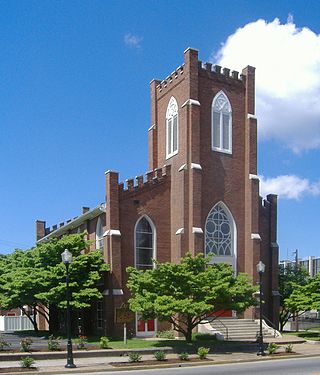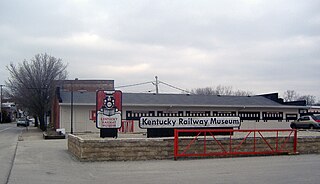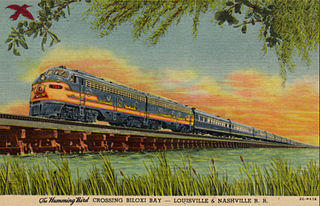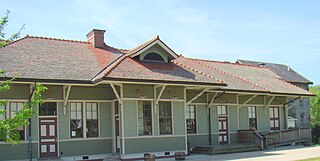
Hopkinsville is a home rule-class city in and the county seat of Christian County, Kentucky, United States. The population at the 2020 census was 31,180.

The Louisville and Nashville Railroad, commonly called the L&N, was a Class I railroad that operated freight and passenger services in the southeast United States.

The Union Station of Louisville, Kentucky is a historic railroad station that serves as offices for the Transit Authority of River City (TARC), as it has since mid-April 1980 after receiving a year-long restoration costing approximately $2 million. It was one of at least five union stations in Kentucky, amongst others located in Lexington, Covington, Paducah and Owensboro. It was one of three stations serving Louisville, the others being Central Station and Southern Railway Station. It superseded previous, smaller, railroad depots located in Louisville, most notably one located at Tenth and Maple in 1868–1869, and another L&N station built in 1858. The station was formally opened on September 7, 1891, by the Louisville and Nashville Railroad. There was a claim made at the time that it was the largest railroad station in the Southern United States, covering forty acres. The other major station in Louisville was Central Station, serving the Baltimore and Ohio, the Illinois Central and other railroads.

The Kentucky Railway Museum, now located in New Haven, Kentucky, United States, is a non-profit railroad museum dedicated to educating the public regarding the history and heritage of Kentucky's railroads and the people who built them. Originally created in 1954 in Louisville, Kentucky, the museum is at its third location, in extreme southern Nelson County. It is one of the oldest railroad stations in the United States.

The Humming Bird was a named train of the Louisville and Nashville Railroad (L&N). The train, inaugurated in 1946, originally ran from Cincinnati, Ohio, to New Orleans, Louisiana, via Louisville, Nashville, Birmingham, Montgomery and Mobile and later via a connection at Bowling Green, Kentucky, to Memphis, Tennessee. A connection to Chicago was provided by the Chicago and Eastern Illinois Railroad.
The Louisville and Nashville Depot, or Louisville and Nashville Railroad Depot or Louisville and Nashville Passenger Station, Louisville and Nashville Railroad Passenger Depot or variations, may refer to the following former and active train stations previously used by the Louisville and Nashville Railroad. Some of these are listed on the National Register of Historic Places (NRHP).

The Historic Railpark and Train Museum, formerly the Louisville and Nashville Railroad Station in Bowling Green, Kentucky, is located in the historic railroad station. The building was placed on the National Register of Historic Places on December 18, 1979. Opened in 1925, the standing depot is the third Louisville & Nashville Railroad depot that served Bowling Green.

Stanford L&N Railroad Depot, also known as Baughman's Mill and Stanford Railroad Depot, is a historic train depot located in Stanford, Kentucky. It was built in 1911 and was used by the Louisville and Nashville Railroad.

The Hopkinsville Commercial Historic District of Hopkinsville, Kentucky, is a historic district listed on the National Register of Historic Places.

The Nashville, Chattanooga, and St. Louis Railway Office and Freight House, simply known as the Paducah Freight House, is a historic railroad freight depot located in the southern portion of downtown Paducah, Kentucky.

The Union Station in Owensboro, Kentucky, is a historic railroad station, built in 1905. Built mostly for the Louisville and Nashville Railroad, the station is made of limestone and slate, and currently is home to several businesses.

The Bardstown station, also known as Old L & N Station, is a historic railroad station on the National Register of Historic Places in the northernmost section of the Bardstown Historic District of Bardstown, Kentucky. Long owned by the Louisville and Nashville Railroad (L&N), it is currently used as the station for the My Old Kentucky Dinner Train, owned by the R.J. Corman Railroad Group.
The former Louisville and Nashville Railroad Lebanon Branch was 77 miles long and ran from Lebanon Junction in Bullitt County to near Mt. Vernon in Rockcastle County. Construction of the branch began in 1857, reaching Lebanon in that year. The line was extended to Crab Orchard in 1866 and completed in 1868. Most of the line was abandoned in 1987. The portion from Stanford to Mt. Vernon was abandoned during the 1990s.

The Western and Atlantic Depot is a historic Western and Atlantic Railroad train depot in Dalton, Georgia. It was built in 1852 in the Greek Revival style. The building is the oldest surviving commercial structure in Dalton and is a "fine example" of depot architecture in Georgia in the mid-1800s. It served as both a freight and passenger station.

The Greenback Depot is a former railroad station located in Greenback, Tennessee, United States. Built in 1914 by the Louisville and Nashville Railroad (L&N), the depot served rail freight and passengers traveling in and out of the Greenback area until 1954. Restored for use as a community events center by Ronald Edmondson in the early 2010s, the depot was listed on the National Register of Historic Places in 2013 in recognition of its role in the area's transportation history.

Louisville and Nashville Railroad Station, also known as L & N Station, was a historic train station located in downtown Evansville, Indiana. It was built in 1902 for the Louisville and Nashville Railroad, and was a Richardsonian Romanesque style rock-faced limestone building. It consisted of a three-story central block with two-story flanking wings, and a one-story baggage wing. It had projecting gabled pavilions and a slate hipped roof.
The Georgian was a long-distance passenger train operated by the Louisville and Nashville Railroad in conjunction with the Chicago and Eastern Illinois Railroad. It operated between St. Louis Union Station and Atlanta's Union Station with a section operated by the C&EI from Evansville to Chicago's Dearborn Station. From Nashville to Atlanta it operated over the tracks of the Nashville, Chattanooga and St. Louis Railway. The introduction of this train made the C&EI's Chicago-Evansville Whippoorwill train superfluous.
The Flamingo was a passenger train operated by the Louisville and Nashville Railroad and the Atlantic Coast Line Railroad between Cincinnati, Ohio, and Jacksonville, Florida, from the 1920s to the 1960s. It carried coaches and sleeping cars.

Richard Montfort, was an Irish-American architect and engineer. He served as the first chief engineer of the Louisville & Nashville Railroad from 1887 to 1905, and in this capacity designed several of the L&N's most important structures, including Union Station in Nashville, Tennessee (1898–1900), and the L&N station in Knoxville (1904–05). He was one of the key persons to contribute to the L&N's growth over the last quarter of the nineteenth century and first quarter of the twentieth into one of the US's most robust corporations.
The Marietta depot is a former freight and passenger stop in Marietta, Georgia. It was originally built in 1864 for the Western and Atlantic Railroad, a railroad between Chattanooga, Tennessee and Atlanta, Georgia. That railroad was absorbed by the Nashville, Chattanooga and St. Louis Railway. In turn, the latter railroad was merged into the Louisville and Nashville Railroad in 1957.

















